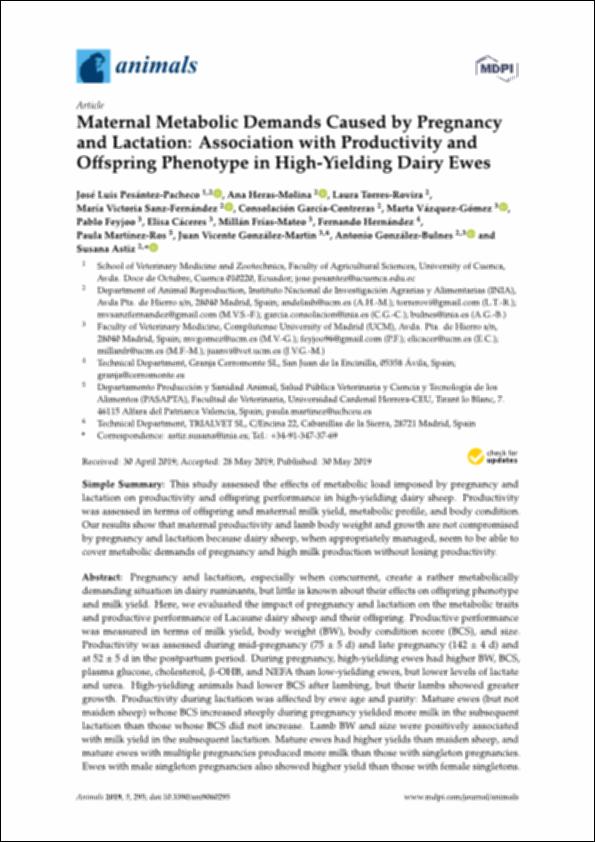Por favor, use este identificador para citar o enlazar este ítem:
http://hdl.handle.net/10637/10758Maternal metabolic demands caused by pregnancy and lactation : association with productivity and offspring phenotype in high-yielding dairy ewes
| Título : | Maternal metabolic demands caused by pregnancy and lactation : association with productivity and offspring phenotype in high-yielding dairy ewes |
| Autor : | Pesántez Pacheco, José Luis Heras Molina, Ana Torres Rovira, Laura Sanz Fernández, María Victoria García Contreras, Consolación Vázquez Gómez, Marta Feyjoo, Pablo Cáceres, Elisa Frías Mateo, Millán Hernández, Fernando Martínez Ros, Paula González Martin, Juan Vicente González de Bulnes López, Antonio Astiz Blanco, Susana |
| Materias: | Ovejas para leche - Metabolismo.; Sheep milk - Metabolism.; Nutrición animal.; Ovejas para leche - Alimentación.; Animal metabolism.; Animal nutrition.; Sheep milk - Feeding and feeds.; Leche de oveja - Producción.; Metabolismo animal.; Sheep milk - Production. |
| Editorial : | MDPI |
| Citación : | Pesántez-Pacheco, JL., Heras-Molina, A., Torres-Rovira, L., Sanz-Fernández, MV., García-Contreras, C., Vázquez-Gómez, M. et al. (2019). Maternal metabolic demands caused by pregnancy and lactation : association with productivity and offspring phenotype in high-yielding dairy ewes. Animals, vol. 9, n. 6 (30 may), art. 295. DOI: https://doi.org/10.3390/ani9060295 |
| Resumen : | Pregnancy and lactation, especially when concurrent, create a rather metabolically demanding situation in dairy ruminants, but little is known about their e ects on o spring phenotype and milk yield. Here, we evaluated the impact of pregnancy and lactation on the metabolic traits and productive performance of Lacaune dairy sheep and their o spring. Productive performance was measured in terms of milk yield, body weight (BW), body condition score (BCS), and size. Productivity was assessed during mid-pregnancy (75 5 d) and late pregnancy (142 4 d) and at 52 5 d in the postpartum period. During pregnancy, high-yielding ewes had higher BW, BCS, plasma glucose, cholesterol, -OHB, and NEFA than low-yielding ewes, but lower levels of lactate and urea. High-yielding animals had lower BCS after lambing, but their lambs showed greater growth. Productivity during lactation was a ected by ewe age and parity: Mature ewes (but not maiden sheep) whose BCS increased steeply during pregnancy yielded more milk in the subsequent lactation than those whose BCS did not increase. Lamb BW and size were positively associated with milk yield in the subsequent lactation. Mature ewes had higher yields than maiden sheep, and mature ewes with multiple pregnancies produced more milk than those with singleton pregnancies. Ewes with male singleton pregnancies also showed higher yield than those with female singletons. These results demonstrate that high-yielding dairy sheep, when appropriately fed and managed, can adequately cover the metabolic demands of pregnancy and high milk production (even when concurrent) without losing productivity. |
| Descripción : | Este artículo se encuentra disponible en la siguiente URL: https://www.mdpi.com/2076-2615/9/6/295 Este artículo pertenece al número especial "Reproductive Management of Sheep and Goats". En este artículo también participan Ana Heras Molina, Laura Torres Rovira, María Victoria Sanz Fernández, Consolación García Contreras, Marta Vázquez Gómez, Pablo Feyjoo, Elisa Cáceres, Millán Frías Mateo, Fernando Hernández, Paula Martínez Ros, Juan Vicente González Martin, Antonio González Bulnes and Susana Astiz. |
| URI : | http://hdl.handle.net/10637/10758 |
| Derechos: | http://creativecommons.org/licenses/by/4.0/deed.es |
| ISSN : | 2076-2615 (Electrónico) |
| Fecha de publicación : | 30-may-2019 |
| Centro : | Universidad Cardenal Herrera-CEU |
| Aparece en las colecciones: | Dpto. Producción y Sanidad Animal, Salud Pública Veterinaria y Ciencia y Tecnología de los Alimentos |
Los ítems de DSpace están protegidos por copyright, con todos los derechos reservados, a menos que se indique lo contrario.


